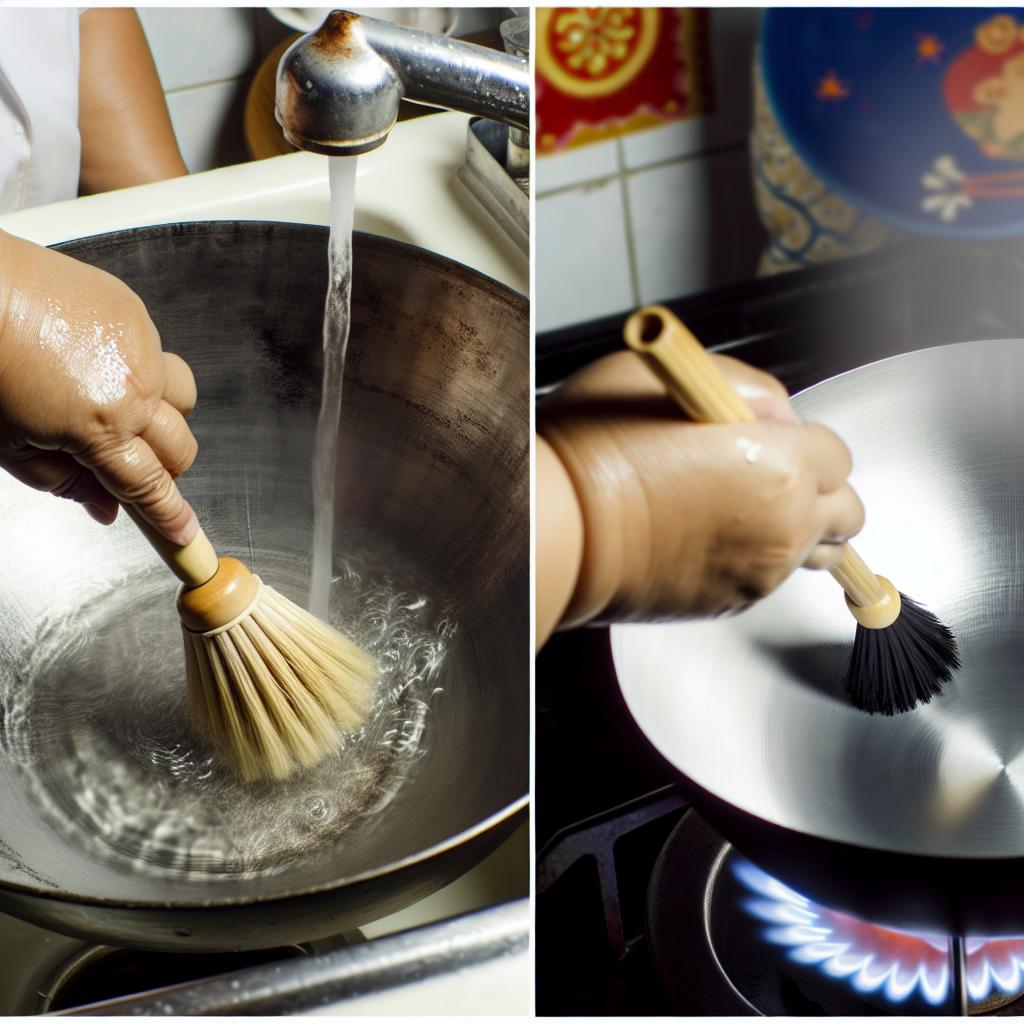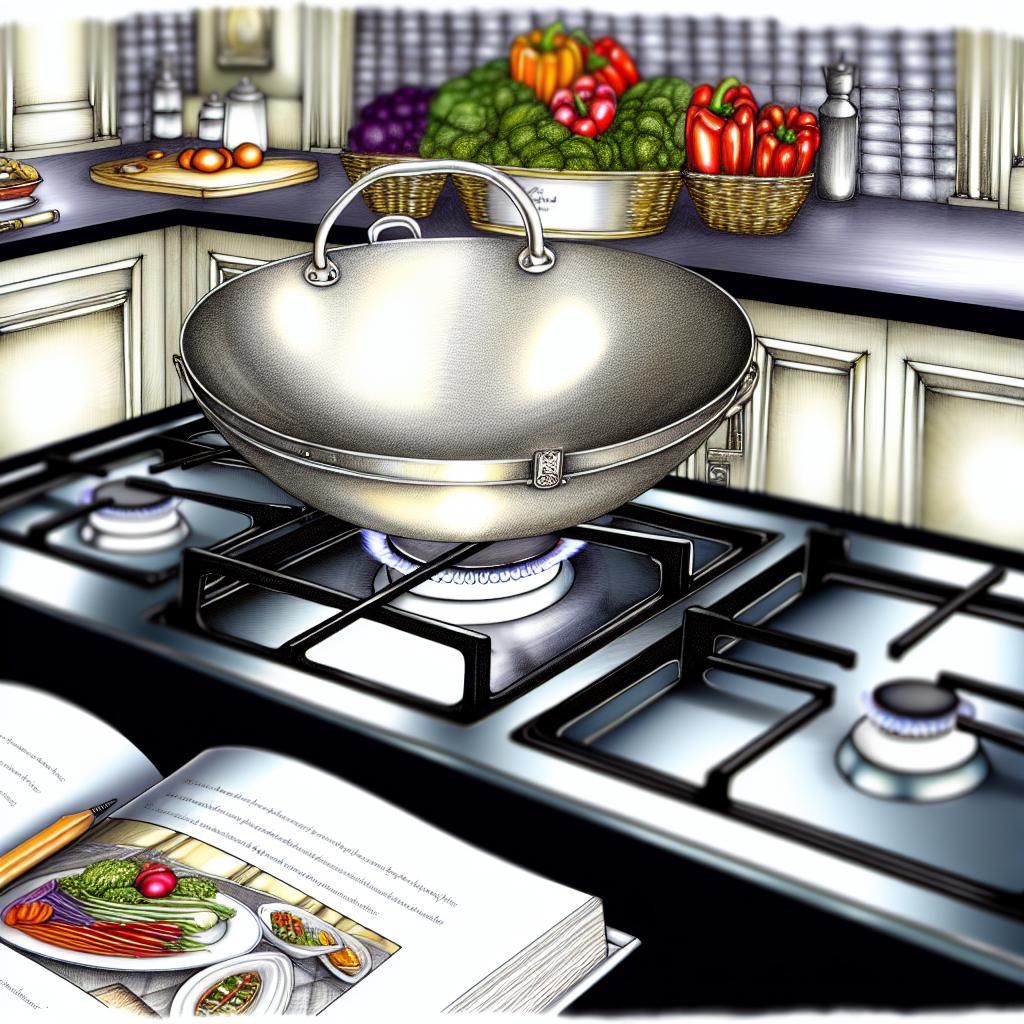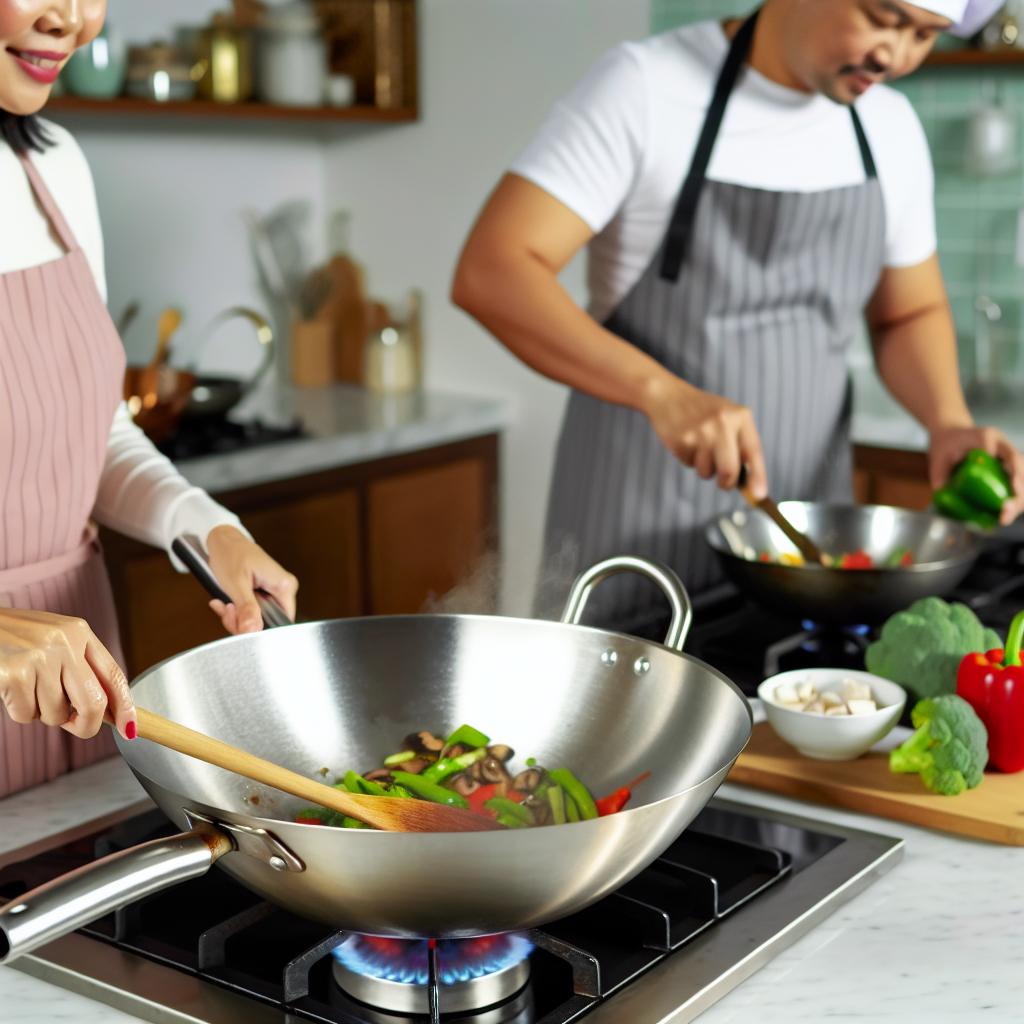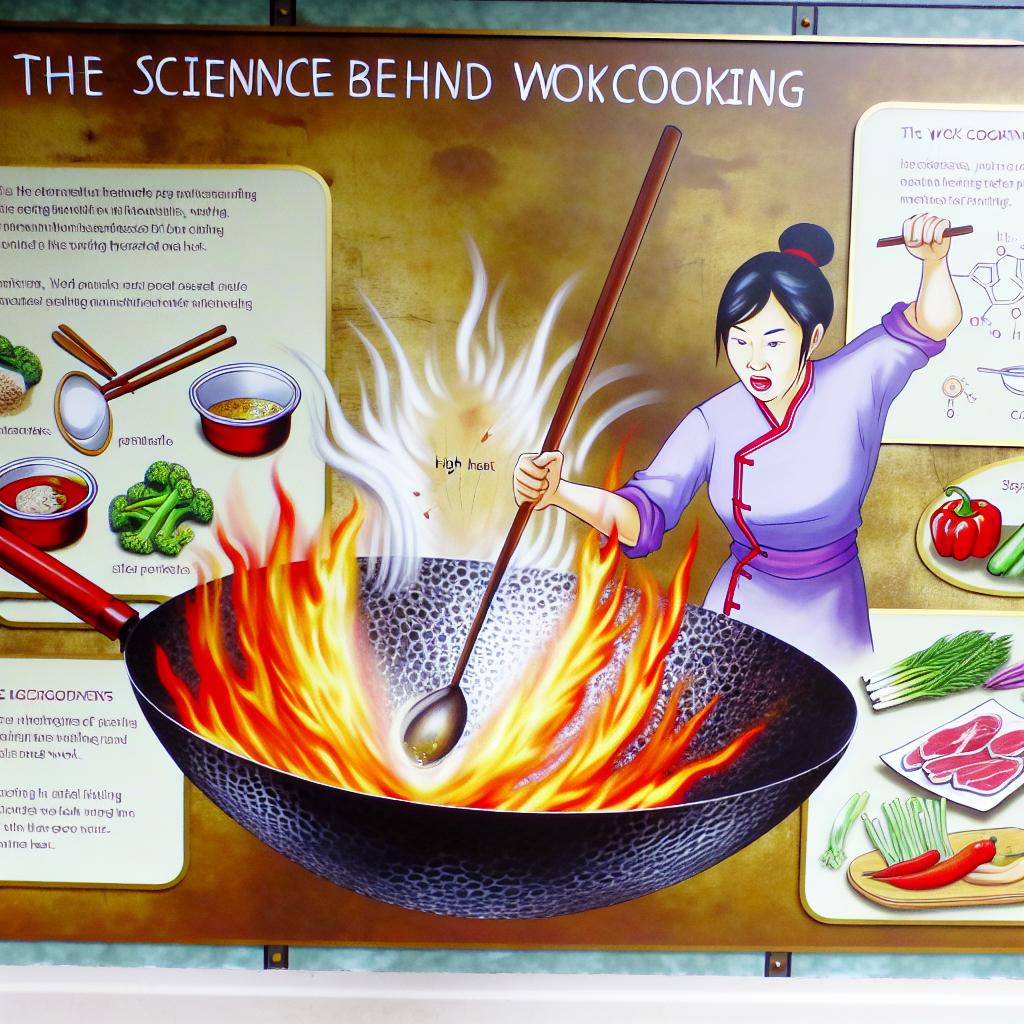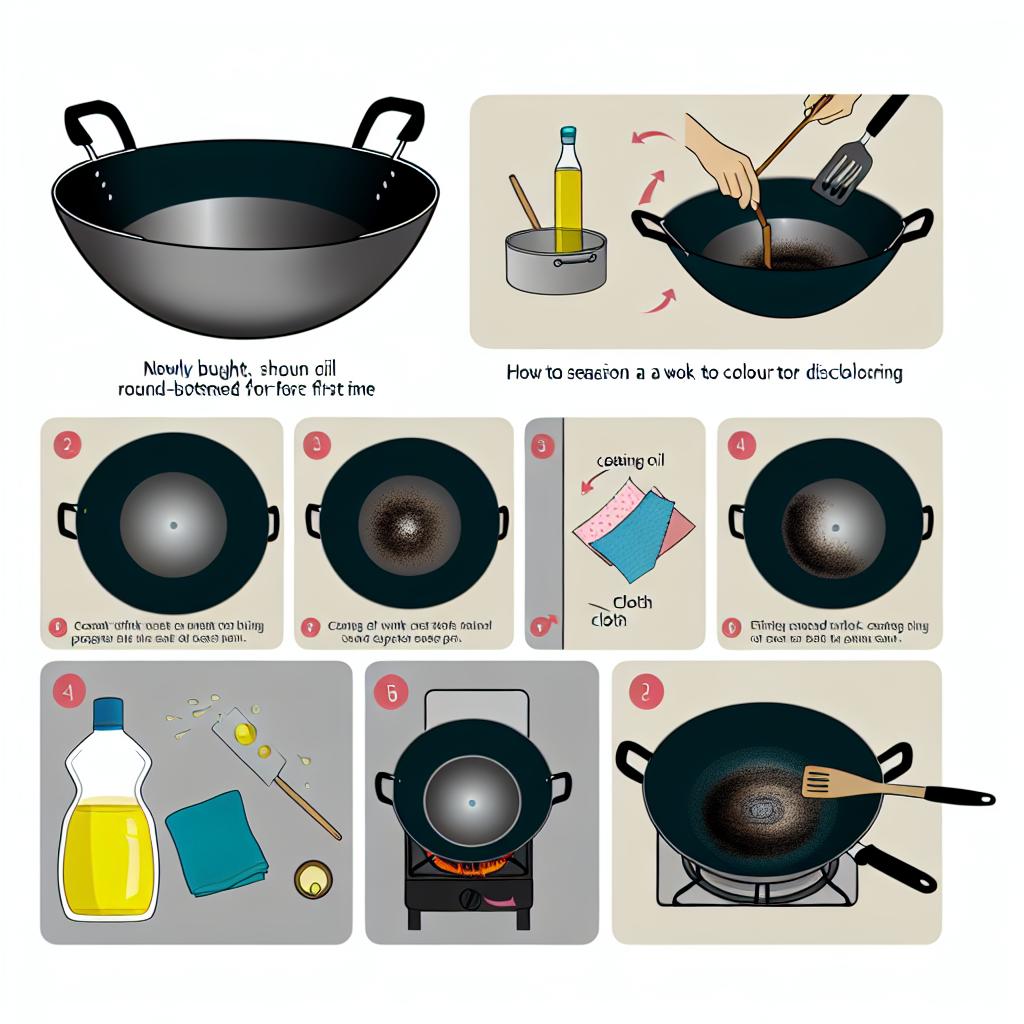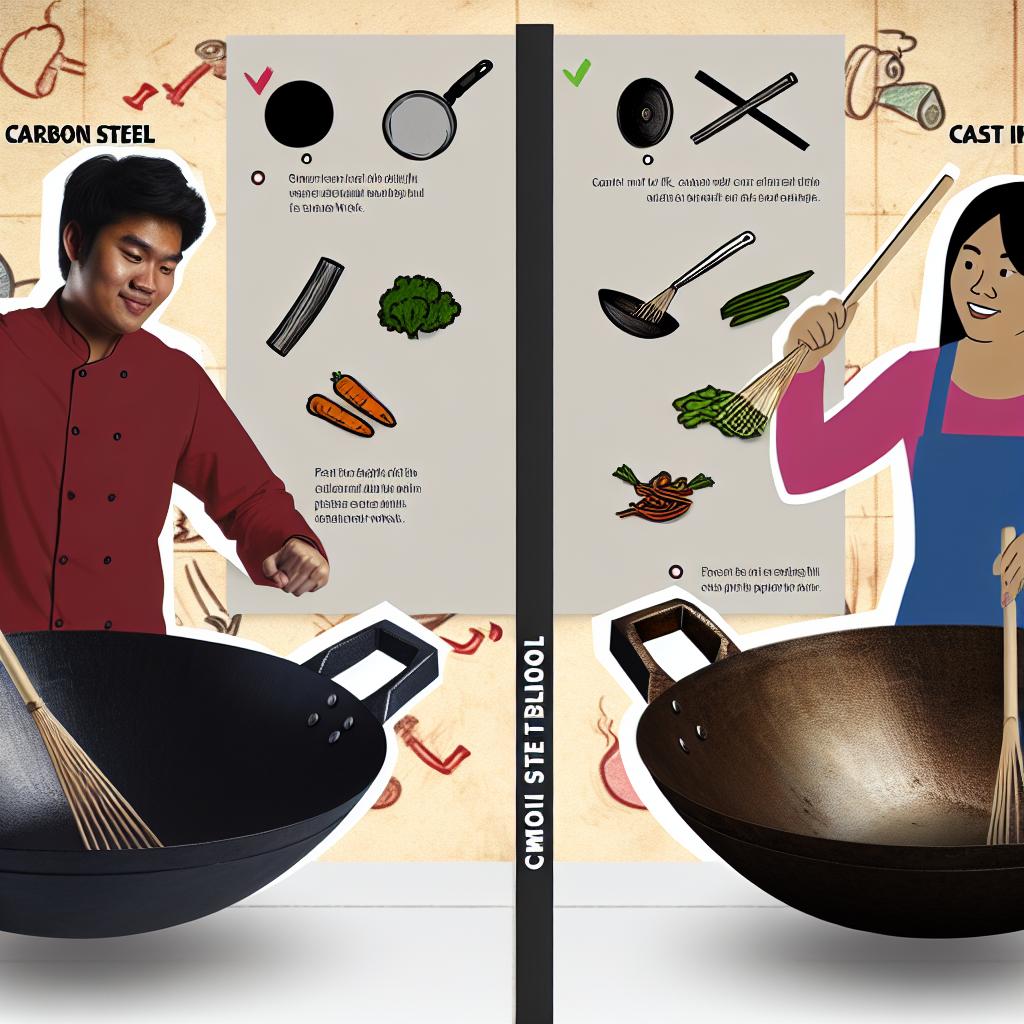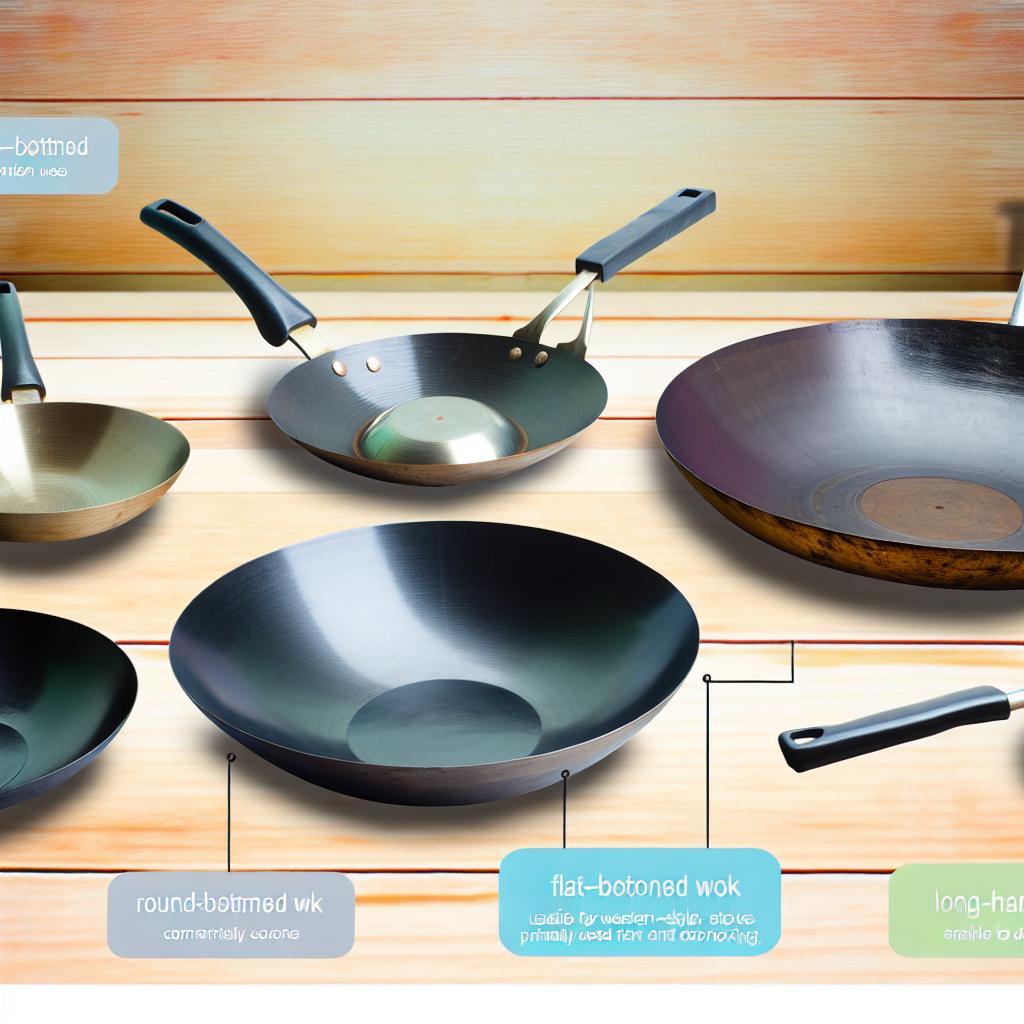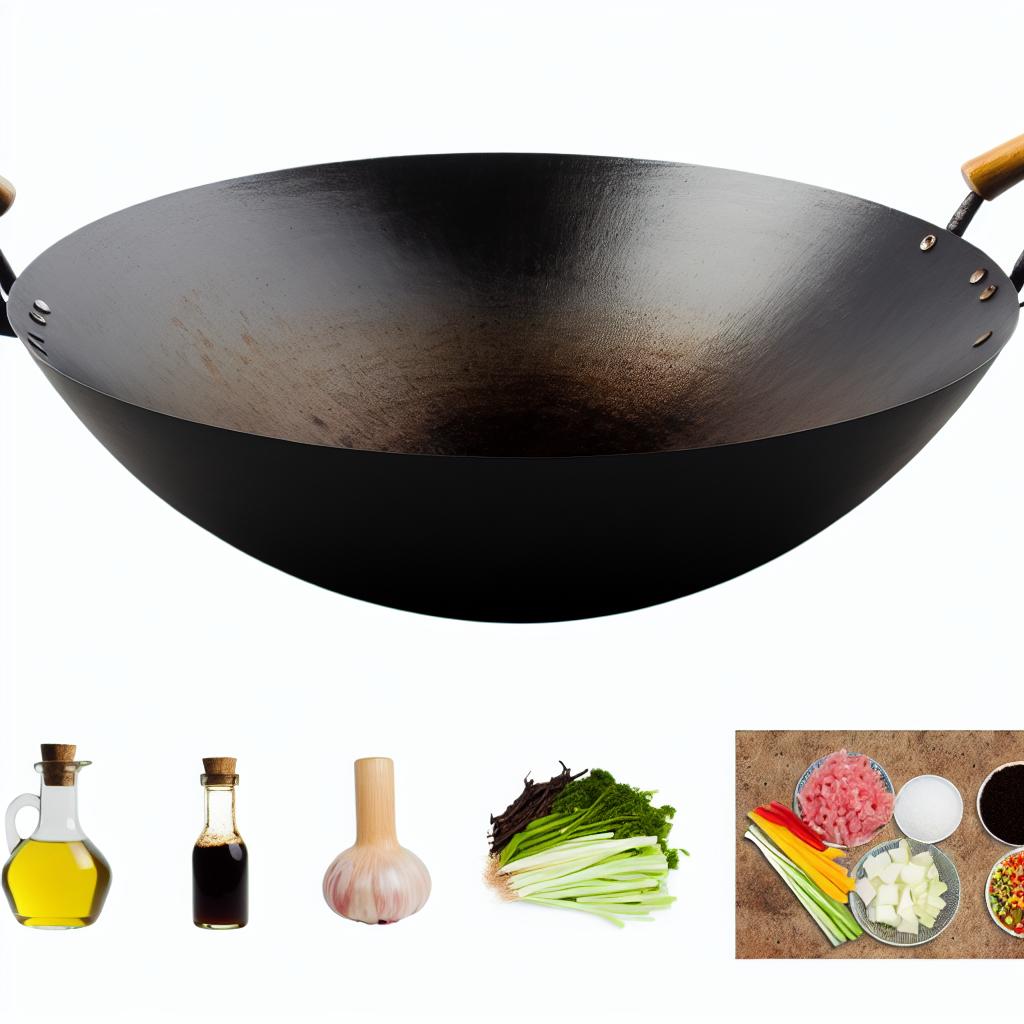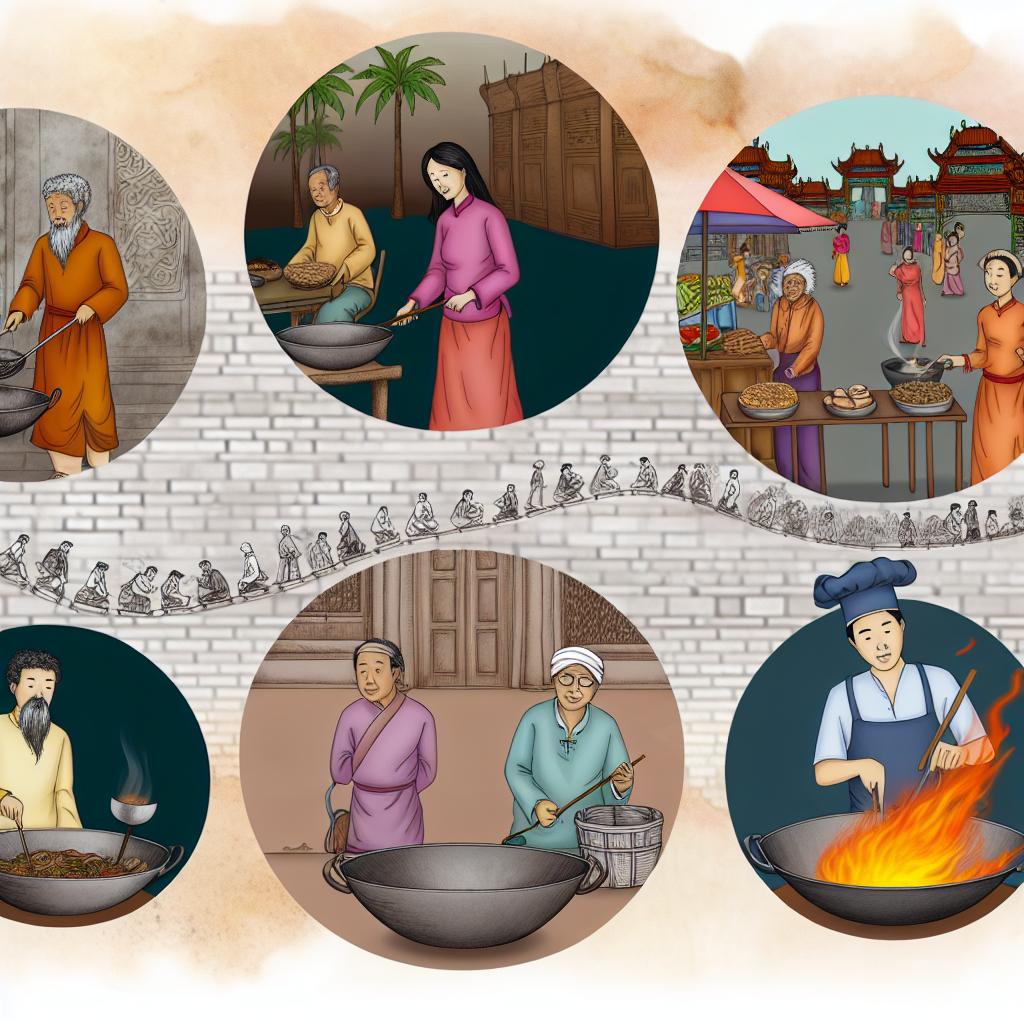Understanding Your Wok
When it comes to cooking, the wok stands out as an indispensable tool in many kitchens. Whether you’re stir-frying vegetables, searing meat, or even deep frying, the wok offers versatility and efficiency. However, to get the most out of your wok, understanding its material and maintenance needs is crucial. Among the most common materials, you’ll find woks made from carbon steel, stainless steel, or cast iron. Each of these materials necessitates specific care practices that can impact both the performance and longevity of your wok.
Initial Seasoning
Before using your new wok, a key step is to remove any protective coating that manufacturers often apply to prevent rust during shipping and storage. This is especially true for carbon steel and cast iron woks. The process of seasoning is crucial for these types and serves to enhance their non-stick properties. Here’s how you can go about it:
Cleaning: Begin by giving the wok a thorough scrub with warm water and a mild detergent. This step ensures that any factory-applied oils or coatings are completely removed.
Heating: Once cleaned, place the wok on a burner and heat it until it is entirely dry. This not only evaporates any residual moisture but also prepares the surface for the next step.
Oiling: Use a cloth or paper towel to apply a thin layer of high smoke point oil—such as vegetable or grapeseed oil—to the interior surface of the wok.
Heating Again: Return the wok to heat on medium-high until it begins to smoke. This heating should be repeated several times, allowing the oil to polymerize. This creates a protective layer that contributes to the wok’s non-stick performance over time.
Regular Use and Maintenance
Proper maintenance doesn’t stop at initial seasoning. Each type of wok material has its own protocol for cleaning and upkeep after every use to ensure that it remains in excellent condition for years to come.
Carbon Steel and Cast Iron Woks: These materials require a bit more attention. After using your wok, clean it with hot water and a sponge or soft scrub brush. Avoid soap unless absolutely necessary, as it can strip away the seasoning that you’ve worked to build. Ensure the wok is completely dry before storing it to prevent rust, applying a light coat of oil after drying will also help keep moisture at bay.
Stainless Steel Woks: More forgiving in nature, stainless steel woks can be cleaned with soapy water without the risk of degrading performance. Nonetheless, it’s advisable to dry them thoroughly before placing them in storage to guard against water spots and potential moisture-related issues.
Deep Cleaning
Even with regular cleaning, there will be times when your wok demands a deeper clean to tackle stubborn food residues or accumulated old oils. Here are the approaches tailored to each material:
– **Carbon Steel and Cast Iron Woks:** Elevate the wok on high heat until it’s very hot and then scrub the surface using coarse salt and a paper towel. This method helps break down and lift off difficult stains.
– **Stainless Steel Woks:** Create a mixture of vinegar and water to lift persistent stains gently. Alternatively, you can use a non-abrasive cleaner to achieve a similar effect without damaging the material.
Preventing Rust
For those using carbon steel and cast iron woks, rust prevention is a primary concern. It’s vital to store your wok in a dry location. If possible, hanging the wok can aid in promoting air circulation—which is beneficial in reducing moisture buildup. However, should rust form, fear not. Scrubbing the affected area with steel wool can remove the rust, after which you should re-season the wok to restore any lost protective qualities.
Storing Your Wok
When it comes time to store your wok, ensure it’s completely dry first. This simple step can prevent the trapping of moisture that could potentially lead to rusting or material degradation. For physical protection, hanging the wok is optimal, but if space is a constraint, stacking them with protective padding (such as felt or cloth pads) between each layer can prevent surface scratching and other forms of damage.
Conclusion
Taking proper care of your wok not only extends its working life but enhances its cooking performance, enabling you to achieve the desired results in every culinary endeavor. For an even deeper dive into wok care and mindful maintenance techniques, consider exploring comprehensive resources available on expert culinary websites or official cooking technique pages. These sources can offer a wealth of information that is specific to the material of your wok and support you in refining your cooking skills whilst preserving your kitchen equipment.
Introduction to Woks
The wok is an indispensable and versatile cooking tool, particularly prevalent in Asian cuisine. Its unique design, characterized by a wide base and high, sloping sides, lends itself to various cooking techniques that can significantly enhance the quality of home-cooked meals. This distinctive shape is ideal for quick cooking methods that preserve the texture and flavor of ingredients. In this article, we will explore the types of woks available, their distinguishing features, and considerations for selecting the perfect wok for your kitchen.
Types of Woks
Carbon Steel Woks: Carbon steel woks hold a prominent place in the hierarchy of wok types due to their excellent heat conduction capabilities and affordability, making them a preferred option for both novices and seasoned chefs. Over time, carbon steel woks develop a natural non-stick surface known as patina when they are properly seasoned. This surface is achieved through the repeated application of oil and heat, which must be meticulously maintained to ensure the wok remains rust-free. Attention to detail in drying and occasionally re-seasoning the wok ensures its longevity and reliability for various cooking methods.
Cast Iron Woks: Renowned for their impressive heat retention abilities, cast iron woks maintain consistent cooking temperatures, which can be particularly beneficial when cooking dishes that require steady heat. Though heavier than their carbon steel counterparts, cast iron woks are equally deserving of a place in the kitchen due to their robustness and durability. Similar to carbon steel, cast iron woks require regular seasoning and care to prevent rust and maintain their non-stick surface. Once properly maintained, they can serve you well for a lifetime, making them a sound investment.
Stainless Steel Woks: Stainless steel woks are celebrated for their durability and ease of cleaning. They offer a dazzling appearance and unwavering robustness; however, they do not match the heat conduction properties of carbon steel. To mitigate this shortfall, many stainless steel woks are often designed with aluminum or copper cores, enhancing heat distribution efficiency. This amalgamation ensures that despite the material’s inherent limitations, your cooking experience remains seamless and effective.
Features to Consider
Flat vs. Round Bottom: The choice between a flat and round-bottomed wok can have a considerable impact on your cooking experience. A flat-bottomed wok is tailored for modern stovetops, including induction and electric ranges. It offers stability and ensures even contact with the heat source, making it versatile for most home kitchens. Conversely, round-bottomed woks recreate traditional cooking dynamics when employed with a wok ring and gas burners. This choice delivers a more authentic cooking experience, particularly for those seeking to master traditional Asian cooking techniques.
Handles: Handles play a significant role in ensuring comfort and safety during cooking. The choice typically narrows down to woks with a single long handle or two small loop handles, each suited for different cooking styles. Long handles allow for agile maneuvering of the wok, facilitating techniques such as flipping and tossing, while loop handles provide a balanced hold, especially when stir-frying for larger gatherings. Regardless of the handle style, ensure they are comfortable and heat-resistant to add to your cooking convenience.
Size: Picking the right size for your wok is pivotal for meeting your culinary needs. A 12 to 14-inch wok stands as the most versatile option, accommodating a plethora of dishes and serving sizes, ideal for typical family meals. Yet, if you frequently cater to large groups, opting for a larger wok may be necessary to ensure all ingredients are cooked evenly without overcrowding.
Non-Stick Coatings
Non-stick woks offer incredible advantages in terms of ease of cleaning and minimizing the usage of oil, aligning with healthier cooking preferences. However, they come with their set of limitations. They do not withstand high temperatures as robustly as traditional materials like carbon steel or cast iron, which might influence their longevity and performance in high-heat applications. Additionally, the coating on non-stick woks is prone to damage from metal utensils, necessitating the use of silicone or wooden utensils to preserve their integrity.
Conclusion
Choosing the appropriate wok for your home cooking is primarily contingent upon aligning the wok’s features with your unique cooking needs and stove compatibility. Evaluating the materials, size, and design features carefully can guide you towards the most suitable wok that complements and elevates your culinary endeavors. For those keen on delving deeper into wok seasoning and maintenance techniques, resources from reputable cooking websites such as Serious Eats and Cooking Light offer extensive insights to ensure that your wok remains a trusted kitchen companion for years to come.
The Versatility of a Wok
The wok is a highly versatile cooking tool that originates from China and has become popular in various parts of the world. Due to its unique shape and features, it can be used for an array of cooking techniques beyond just stir-frying. The round-bottomed pan allows for even heat distribution, making it suitable for deep-frying, steaming, and even smoking foods. Additionally, its flared sides allow for comfortable stirring and tossing of ingredients.
Economical Cooking
Using a wok can be economical in terms of both time and energy. The high heat required for cooking with a wok means foods cook faster, which can save on electricity or gas. For more insight into energy-efficient cooking appliances, you can refer to this Energy Saver link. Additionally, the rapid cooking process not only allows for savings on energy costs but also means that meal preparation can be quicker, allowing for more efficient time management in the kitchen. This makes it especially beneficial for busy households or those who are looking to minimize their time spent cooking without compromising on the quality of meals.
Healthier Meal Preparation
The design of the wok is conducive to healthier cooking methods. Due to the small amount of oil required, as well as the rapid cooking process, nutrients in vegetables are better preserved compared to other cooking methods. Ingredients retain their color, texture, and vitamins, contributing to a nutritious diet. Moreover, the quick cooking technique allows ingredients to maintain their natural flavors, offering more taste with less need for additional seasonings or fats. The ability to cook a variety of meals in a wok, from steaming to frying, all while maintaining the inherent nutritional value of the ingredients, showcases its effectiveness as a tool for healthier cooking.
Durability and Longevity
Woks are generally made from materials such as carbon steel or cast iron, which are known for their durability. They could last for many years if properly maintained. Carbon steel woks, for instance, require seasoning, an essential process that creates a natural non-stick layer, enhancing both the flavor and longevity of the cooking surface. Proper care, including routine cleaning and re-seasoning, can ensure the wok remains in optimal condition over time. Additionally, the initial investment in a high-quality wok can lead to long-term savings by eliminating the need for frequent replacement kitchenware items. This durability makes woks not just essential for their cooking capabilities, but also economical in terms of long-term kitchen investments.
Enhancing Flavors Through Seasoning
The unique ability of a wok to be seasoned allows it to build flavor over time. As a wok is used, it becomes naturally non-stick and accumulates a layer known as the “patina.” This enhances the flavor of subsequent dishes cooked in the wok. Seasoning your wok properly ensures an optimum cooking experience each time, and more information on this process can be found in specialized culinary guides or reputable cooking sites. Additionally, as the wok is repeatedly seasoned and used over time, the patina develops a unique flavor profile that can add depth to various dishes that are prepared in it, giving each meal a distinctive taste that goes beyond standard cooking methods.
The capability of a wok to be multi-functional extends its usability across different culinary traditions and cooking styles. Beyond traditional Chinese dishes, the versatility of the wok makes it an ideal tool for Western cuisines as well, allowing chefs and home cooks alike to explore a range of recipes.
In conclusion, cooking with a wok offers numerous benefits, from versatility and cost-effectiveness to healthier food preparation and long-term kitchen value. Investing in a good quality wok can significantly enhance your cooking repertoire, while also making meal preparation more enjoyable and efficient. One key advantage is the ability to use a single tool for a variety of cooking methods, thereby minimizing the need for multiple cookware items, simplifying kitchen organization, and streamlining cooking processes.
The wok’s design, which facilitates fast, even cooking and easy handling, complements different dietary needs and preferences, allowing for the preparation of both simple and complex dishes. Whether you are deep-frying, stir-frying, or smoking, the wok’s construction is such that it adapts well to each cooking style. Furthermore, the health benefits associated with using a wok, from nutrient retention to reduced oil necessity, align well with modern culinary trends that emphasize nutritious, balanced meals.
Although more prevalent globally now, the wok’s origins are steeped in rich culinary traditions, paying homage to the ancestry of Asian cooking techniques, which underline the fusion of flavors and techniques. The incorporation of a wok into your cooking routine not only broadens the spectrum of dishes that can be prepared but also supports a culinary journey that respects and reinvents traditional cooking methods.
Overall, the advantages of utilizing a wok in both personal and professional kitchens speak to its durable design and ability to consistently deliver delicious, healthy, and efficient meals. It is a testament to the blending of form and function, a timeless tool that, when appropriately employed and maintained, will remain an invaluable asset to cooks everywhere.
The Science of Heat Distribution in Wok Cooking
Wok cooking is a cornerstone of many Asian cuisines, characterized by its unique use of high heat and specific stir-frying techniques. To create the authentic taste and texture of dishes cooked in a wok, it’s essential to understand the scientific principles that govern heat distribution within this unique cooking vessel.
The metal used in a wok is crucial in transferring heat efficiently from the source to the food being cooked. Most woks are crafted from materials like carbon steel or cast iron, both of which provide excellent heat distribution due to their conductive properties. The rounded shape and thin walls of a wok are designed for rapid heating and cooling. This characteristic is essential when preparing various dishes that require quick, high-temperature cooking, such as stir-frying, as well as those needing a consistent temperature for frying in oil.
Maillard Reaction and Flavors
At the heart of wok cooking lies the Maillard reaction, a vital chemical interaction between amino acids and reducing sugars that occurs at high temperatures. This reaction is what browns food and develops the complex flavors that are often sought after in culinary creations. When stir-frying in a wok, the high surface temperatures reached facilitate the Maillard reaction, significantly enhancing the taste and aroma of the dish. This reaction is critical for developing the rich, savory flavors that are emblematic of stir-fried foods.
Another advantage of the rapid cooking technique associated with wok use is that it prevents overcooking. Quick exposure to high heat means that vegetables maintain their vibrant colors and crispy textures. Furthermore, the brief cooking time has the added benefit of preserving the maximum amount of vitamins and nutrients, which might otherwise be lost in slower cooking methods.
The Role of Wok Hei
An essential and unique concept in wok cooking is known as wok hei, which can be translated to mean the “breath of the wok.” This term describes a complex smoky aroma and flavor attained through high-heat cooking methods. Wok hei is accomplished when various compounds within the food are vaporized and chemically altered by the intense heat, which then imparts a distinctive and highly prized flavor to the finished dish. Achieving wok hei is often considered a hallmark of excellent wok cooking and requires skill to master.
Material Selection and Its Impact
The choice of material for constructing a wok markedly influences its performance during cooking. Carbon steel and cast iron are the most common materials used, selected primarily for their superior heat conductivity and durability. As these materials wear over time, they naturally develop a non-stick patina, which can add unique flavors to food prepared in them.
Advantages of Carbon Steel
Carbon steel woks are particularly favored due to their relatively light weight, which makes them easier to maneuver during the vigorous actions involved in stir-frying. Despite their lighter weight compared to cast iron, carbon steel woks offer excellent thermal conduction, which is crucial for achieving the high temperatures needed quickly. This property makes carbon steel a popular choice for cooks who prioritize speed and agility in their cooking.
Properties of Cast Iron
On the other hand, cast iron woks, while heftier, have the advantage of retaining heat for prolonged periods. This characteristic allows them to provide a more substantial cooking surface, ideal for dishes that require extended cooking time but still benefit from high temperatures. The ability of cast iron to maintain consistent heat levels is particularly beneficial for recipes that might otherwise cool down too quickly if prepared in other materials.
Conclusion
A deep understanding of the scientific principles behind wok cooking can greatly enhance both the techniques used and the outcomes achieved in the kitchen. The strategic use of heat distribution, the chemical intricacies of the Maillard reaction, and the deliberate choice of construction materials are all pivotal in creating the quintessential flavors that define wok-prepared dishes. By appreciating these underlying factors, cooks are better able to reproduce the authentic tastes and textures that are hallmarks of this cooking style. For further reading on wok materials and their scientific properties, you may visit this resource for more information.
Introduction
When you purchase a new wok, particularly those crafted from carbon steel or cast iron, the task of seasoning it becomes a paramount step before it sees its first culinary use. The seasoning process is more than a mere preparatory measure; it’s a foundational routine that bestows a protective layer upon your wok. This layer serves dual functions: shielding the wok from rust and creating a naturally non-stick surface that is invaluable for cooking. This guide meticulously outlines each step necessary to season a wok properly upon its acquisition.
Understanding the Need for Seasoning
Seasoning is an irreplaceable process for woks made from carbon steel and cast iron. Not only does it furnish a protective layer over the surface, but it also enhances the wok’s utility by forming a polymer derived from heated oil. This process not only awards the wok with a natural non-stick property but also contributes significantly to the durability and longevity of the cookware.
The Chemistry Behind Seasoning
The process of seasoning your wok is steeped in basic chemistry. When oil is heated past its smoke point, it undergoes a transformation into a polymer. This polymer attaches itself to the wok’s surface, creating a robust, water-resistant, and durable layer that mimics the effects of traditional non-stick coatings without the chemical concerns. The polymerization ensures that food does not stick to the wok’s surface during cooking, thereby making the process of stir-frying or sautéing more efficient and delightful.
Materials Required
To properly season your wok, you will need to gather a specific set of materials:
– A new carbon steel or cast iron wok.
– A choice of cooking oil that boasts a high smoke point; suitable options include canola, grapeseed, or peanut oil.
– Paper towels or a soft cloth, which will facilitate the application of the oil.
– A scrubber or sponge for the necessary preliminary cleaning.
– A stovetop burner, which serves as the primary heat source in this process.
Step-by-Step Process
1. Cleaning the Wok
Most new woks arrive with a protective coating applied at the factory to prevent any damage during transportation. Before you embark on the seasoning process, it is crucial to remove this coating thoroughly. Begin by washing the wok with warm soapy water, employing a sponge or scrubber to cleanse both the interior and exterior surfaces. Ensuring to rinse well afterward is essential. Finally, pat the wok dry using a clean towel to prepare it for further steps.
2. Heating the Wok
Position the cleaned wok on a stove burner, setting it to medium-high heat. As the wok begins to heat, be prepared for changes in color and anticipate possible smoke emission—both are entirely typical. The objective is to heat the wok until its hue begins to transform visibly, which is indicative of it reaching the required temperature for oil application.
3. Applying Oil
Once the wok has attained the necessary heat, carefully remove it from the stove. Proceed to add a thin film of oil, ensuring that you apply it both inside and outside the surface. This is a delicate phase where using a paper towel to evenly distribute the oil is advisable. Ensure vigilance so that the oil layer remains thin, thereby avoiding any pooling of the oil, which can lead to uneven seasoning.
4. Heating the Oil
After the application of oil, return the wok to the stove, maintaining the medium-high heat setting. Allow this process to persist for approximately 10-15 minutes. During this period, it is beneficial to maneuver the wok to guarantee that all areas receive an equitable amount of heat, facilitating uniform polymerization of the oil to form the initial non-stick layer.
5. Cooling and Repeating
At the juncture where a light black or brown patina starts to manifest on the wok’s surface, remove it from the heat source and permit it to cool naturally. The effectiveness of the seasoning can be amplified by repeating this cooling and oil-heating process at least two to three times, thus reinforcing the seasoning layer.
Maintaining Your Seasoned Wok
The achievement of proper initial seasoning marks only the beginning of your journey with your wok. To sustain and enhance its non-stick surface, regular maintenance is essential. As a rule, always cleanse your wok with hot water post-use, steering clear of soap, which can strip away the seasoned layer. Following each culinary session, ensure the wok is thoroughly dried before applying a thin layer of oil once more prior to storing it. Consistency in this practice will see your wok becoming even more seasoned with continued use.
Advantages of Maintenance
Regular maintenance practices do more than preserve the seasoned surface. They also significantly reduce the risk of rust developing, keeping the wok ready for quick and efficient cooking at any time. The more you engage your wok in cooking, and by adhering to correct maintenance habits, the smoother and more effective its non-stick capabilities will become over time.
Conclusion
The practice of properly seasoning your wok is synonymous with ensuring superior cooking results and extending the lifespan of this indispensable kitchen tool. Adhering meticulously to these outlined steps allows you to build a naturally non-stick surface, perfect for stir-frying and other cooking techniques integral to Asian cuisine. With ongoing use and care, the wok will evolve into a prized possession, increasingly seasoned and efficient in its culinary applications.
Overview of Carbon Steel and Cast Iron Woks
When it comes to making delicious stir-fried dishes, choosing the right wok is essential. Two popular materials for woks are carbon steel and cast iron. Both have unique properties that can affect cooking performance, maintenance, and longevity.
Material Composition and Cooking Characteristics
Selecting a wok involves understanding the composition and cooking prowess of the materials. The difference in how carbon steel and cast iron woks are crafted plays a significant role in their functionality and efficiency.
Carbon Steel Woks
Carbon steel woks are crafted from a blend of iron and carbon. This combination imparts crucial characteristics that favor efficient cooking. Known for their lightweight construction and superb heat conductivity, carbon steel woks are celebrated by many cooking enthusiasts. The rapid heat conduction allows these woks to heat up swiftly and adjust quickly to temperature changes, making them ideal for the quick cooking style required in stir-frying. With regular and proper seasoning, the surface of a carbon steel wok can develop a natural non-stick patina, enhancing its cooking capabilities over time.
Cast Iron Woks
Conversely, cast iron woks are known for their remarkable durability and heat retention capabilities. While they take a bit longer to heat up compared to their carbon steel counterparts, they excel in maintaining stable and consistent temperatures once they are hot. This trait makes cast iron woks highly suitable for dishes that require extended, even cooking processes. Like carbon steel, cast iron also benefits from developing a seasoned surface over time, which adds a degree of non-stick capabilities and enriches the dish’s flavors.
Maintenance and Care
Proper care of woks ensures longevity and optimal cooking performance. Understanding how to maintain them is vital for any wok owner.
Seasoning
Both carbon steel and cast iron woks necessitate regular seasoning to develop and maintain a natural non-stick layer. Seasoning is not merely for better food release; it is a protective measure against rust. Over time, the seasoning can also enhance the wok’s cooking performance by imparting unique flavors to the food being prepared. Detailed seasoning techniques can be explored through useful resources like Serious Eats. Consistent seasoning ranks as one of the most crucial maintenance tasks for those looking to preserve their wok’s integrity and effectiveness.
Cleaning and Storage
The process of cleaning woks varies slightly between the two types due to their physical characteristics. Carbon steel woks, being lighter in weight, are generally easier to clean. They usually require a quick scrub and thorough drying to avoid rust formation. In contrast, the heavier cast iron woks may need more effort during cleaning, primarily because of their weight and the likelihood of residues sticking to their surfaces. Post-cleaning, both types of woks benefit from a light oil coating to uphold the seasoning layer and prevent oxidation, thus prolonging their useful life.
Weight and Maneuverability
The weight and maneuverability of a wok can significantly impact its usability in the kitchen. These features should align with the cook’s style and physical ability to handle the wok.
Carbon steel woks are generally lightweight, making them highly maneuverable. This feature caters to cooks who enjoy the agility that these woks provide. The lightness of carbon steel woks facilitates fluid tossing and stirring of ingredients, making them an excellent choice for chefs who favor dynamic cooking approaches. On the flip side, cast iron woks are notably heavier, which can be a double-edged sword. While they offer stability during cooking, their weight might present challenges when flipping ingredients or moving the wok off the heat, a factor that should be considered before making a purchase decision.
Price and Availability
The cost and availability of woks can influence the purchasing decision for both amateur and professional chefs.
Carbon steel woks tend to be more affordable, appealing to home cooks and professional chefs alike. Their availability is widespread, meaning more options in terms of brands and designs are accessible to consumers. On the other hand, cast iron woks are typically priced higher. This price reflects their inherent durability and robustness, qualities valued by those who engage in frequent or intense wok cooking. While the initial investment in a cast iron wok may be higher, its extended lifespan and cooking benefits can justify the cost in the long run.
Conclusion
Choosing between a carbon steel and a cast iron wok largely depends on the intended use and personal preference. Carbon steel woks, with their quick heating and agility, are ideal for fast-cooking techniques like stir-frying. Their lightweight nature is beneficial for cooks who prefer easily maneuverable cookware. In contrast, cast iron woks excel in heat retention and durability, lending themselves well to slow cooking or searing tasks that demand steady, prolonged heat. The choice between the two materials should align with one’s specific cooking needs and style, considering factors such as heat conduction, maintenance effort, and budget. Understanding the distinct advantages of each material ensures a personalized and fitting selection for your culinary adventures.
Introduction to Woks
The wok is a versatile cooking pan with a deep, round bottom, primarily used in Asian cuisine. Its unique design allows for a variety of cooking methods, making it a staple in many kitchens worldwide. In this article, we will explore the different types of woks and their specific uses, helping you understand which kind might best suit your cooking style.
The Versatility of Woks
The adaptability of woks comes from their design, which allows them to be used for several cooking techniques. Their deep structure enables stir-frying, boiling, steaming, deep-frying, and smoking, turning them into a multipurpose kitchen tool. This versatility explains their enduring presence in both traditional and modern cooking arenas.
Materials and Their Impact on Cooking
When choosing a wok, the material it is made from plays a significant role in dictating its cooking performance and durability. Understanding these material differences can greatly enhance one’s cooking experience.
Carbon Steel Wok
Characteristics and Benefits: Carbon steel woks are chosen by many for their superb heat conductivity, allowing them to heat and cool quickly. This quick response to heat makes them ideal for dishes that require fast cooking. Though lightweight, they develop a natural non-stick surface over time when seasoned correctly.
Uses: Perfect for stir-frying—the swift heating aids in cooking vegetables and proteins quickly while retaining their flavors and nutrients. Moreover, the pan’s design also supports steaming, deep-frying, and smoking. Carbon steel is often preferred by chefs for its balance of responsiveness and maintainability.
Maintenance Tips for Carbon Steel Woks
To extend the life of a carbon steel wok, regular seasoning is recommended. After each use, clean the wok gently with a soft sponge to avoid removing the seasoned surface. Storing it in a dry place helps prevent rust, which can be a concern for many carbon steel products.
Cast Iron Wok
Characteristics and Benefits: Cast iron woks are recognized for their robust heat retention capabilities. Although these woks are heavier, their heat retention can be advantageous for cooking methods that benefit from consistent temperatures, leading to even cooking.
Uses: The consistent heat makes them suitable for deep-frying and slow simmering dishes like braises or stews. Additionally, their ability to maintain heat makes them excellent for high-heat searing, a method crucial for achieving the desired texture in some recipes.
Maintaining a Cast Iron Wok
Like carbon steel, cast iron requires regular seasoning to maintain its surface. Avoid soap, which can strip this coating. A light coating of oil after each use helps prevent rust and maintains the pan’s condition.
Non-Stick Wok
Characteristics and Benefits: Non-stick woks offer convenience, particularly for those wary of the maintenance required by other materials. The non-stick coating reduces the need for much oil and facilitates easier cleaning, appealing to those seeking healthier cooking options.
Uses: Suited for low to medium heat cooking, ideal for sautéing and stir-frying delicate foods like eggs or fish. However, exposure to high heat can damage the non-stick coating, limiting their suitability for some Asian cooking techniques.
Care Guidelines for a Non-Stick Wok
To ensure longevity, use non-metal utensils to prevent scratching the surface. Cooking sprays can degrade the coating, so it’s preferable to use minimal amounts of traditional oils like vegetable oil. A thorough rinse with warm water and a soft sponge suffices for cleaning.
Stainless Steel Wok
Characteristics and Benefits: Stainless steel woks are known for their exceptional durability. The material is resistant to rust and corrosion, thus requiring less maintenance compared to carbon steel or cast iron. However, stainless steel does not develop a non-stick surface, which may demand slight adjustments in cooking practices.
Uses: It excels in braising and boiling due to its ability to handle acidic foods without adverse reactions. The wok’s polished appearance makes it suitable for presenting dishes directly at the table, marrying function with aesthetics.
Cleaning and Maintenance for Stainless Steel Woks
Stainless steel can withstand a bit more abrasive cleaning compared to other materials, though it’s still wise to avoid steel wool or harsh scrubbers that can scratch the surface. Typical kitchen acids, like citrus, won’t damage stainless steel, adding to its utility.
Electric Wok
Characteristics and Benefits: These woks integrate a heat source, making them highly convenient and portable. Often featuring temperature controls, electric woks are accessible for those new to Asian cooking methods or for environments lacking a stovetop.
Uses: Their versatility extends to stir-frying, steaming, and simmering. Electric woks prove particularly useful in small or communal living arrangements where traditional single-range cooking may not be available.
Caring for an Electric Wok
Carefully follow the manufacturer’s instructions for cleaning and maintenance. Disconnect it from the power source before cleaning to ensure safety. Avoid submerging the heating elements and focus on keeping the cooking section clean and oil-free.
Choosing the Right Wok for Your Kitchen
Selecting a wok depends highly on your cooking habits, available kitchen equipment, and personal preferences. A traditionalist with an affinity for high-heat methods might favor a carbon steel or cast iron wok, while someone needing convenience might opt for a non-stick or electric model.
Conclusion
Different woks cater to diverse styles and culinary needs. Familiarity with their unique characteristics can improve your cooking experience, making meal preparation more efficient and enjoyable. Ultimately, consulting professional chefs or reliable kitchenware experts can provide further personalized guidance in choosing the most suitable wok for your kitchen.
What is a Wok?
A wok is a versatile cooking vessel originating from China, commonly used across various Asian cuisines. Its unique design makes it ideal for a range of cooking techniques, solidifying its place as an indispensable tool in many kitchens worldwide.
Design and Structure
The wok is notable for its distinctive shape, marked by a rounded bottom and high, flared sides. Traditionally crafted from carbon steel, woks are also available in materials such as cast iron, stainless steel, and non-stick coatings. This bowl-shaped design facilitates even heat distribution, which is crucial for the cooking styles typically associated with woks.
Materials Used in Wok Construction
The material from which a wok is made significantly impacts its cooking performance and maintenance requirements. Here, we’ll briefly examine the common materials used to construct woks and their respective characteristics:
Carbon Steel: Esteemed for its heat conduction properties, carbon steel woks heat up rapidly and evenly. Lightweight and affordable, they are favored by many professional and home chefs alike. However, they require proper seasoning to prevent rust and to develop a non-stick surface over time.
Cast Iron: While heavier and slower to heat up compared to carbon steel, cast iron woks retain heat exceptionally well, offering consistent cooking temperatures. These woks also need to be seasoned and are renowned for their durability.
Stainless Steel: These woks are appreciated for their durability and low maintenance. They do not rust and do not require seasoning. However, they might not offer the same heat conduction as carbon steel or cast iron, which can impact cooking.
Non-Stick Coatings: Woks with non-stick coatings are user-friendly, reducing the need for excessive cooking oil and simplifying cleanup. Care must be taken, however, to avoid scratching the non-stick surface, which can impact performance over time.
Types of Woks
There are primarily two types of woks:
– Round-bottomed woks: These are the most common and are ideal for use on gas stoves. Their shape allows for a high heat concentration at the bottom, perfect for stir-frying.
– Flat-bottomed woks: These woks are more suited to electric stovetops, as they offer a larger surface area suitable for frying.
Choosing the Right Wok for Your Cooking Needs
Selecting the appropriate type of wok depends not only on your cooking style but also on the type of stove you have. For instance, round-bottomed woks work best on traditional gas stoves. Meanwhile, flat-bottomed woks are notably efficient on electric stovetops, providing a stable base.
Uses of a Wok
The wok’s versatility is evident in its ability to perform a wide array of cooking techniques. While stir-frying is the most commonly associated method, a wok can also be utilized for steaming, boiling, deep-frying, and even smoking foods.
Stir-frying
Stir-frying involves cooking ingredients quickly at high temperature while constantly stirring. The wok’s shape facilitates the swift movement of food and its high sides help prevent spillage. This method effectively preserves the texture and flavor of vegetables and meats, making it fundamental in many Asian recipes.
Essential Tips for Stir-frying
To achieve the best results while stir-frying, it is crucial to heat the wok before adding oil. This prevents sticking and ensures even cooking. Cutting ingredients into uniform pieces allows for even cooking, and it’s essential to keep them moving within the wok to maintain the high temperature and prevent burning.
Steaming
By placing a rack inside the wok and adding a small amount of water, the wok can be transformed into a steamer. This technique is often employed for cooking dumplings, fish, and vegetables, allowing for a healthy and gentle cooking method that preserves nutrients and flavors.
Setup for Steaming
To steam using a wok, position a steaming rack inside the wok and fill the base with just enough water so that it does not touch the food placed on the rack. A wok lid or a simple kitchen towel will help trap steam. Regular attention is needed to ensure water does not dry out.
Advantages of Using a Wok
One of the primary benefits of employing a wok is its capacity to cook food quickly over high heat with minimal oil usage. This results in healthier meals with more vibrant flavors and textures. Furthermore, the wok’s shape facilitates efficient energy use by concentrating heat on the cooking surface.
Energy Efficiency and Cooking Benefits
Due to its round shape, the wok produces efficient energy use in kitchens. The focal point of the heat at the bottom allows for quick cooking, reducing energy consumption.
Caring for Your Wok
Proper care and maintenance are critical to extending the life of a wok, especially for those made of carbon steel or cast iron. Seasoning your wok helps to create a natural non-stick surface that gets better with continuous use. It’s advisable to clean regularly with hot water and a soft sponge; avoiding soap use is crucial, as it can remove the seasoned coating.
Steps for Seasoning a Wok
Seasoning a wok involves cleaning it and then applying a thin coat of oil over the surface. Heating the wok on a stove until it starts to smoke slightly lets the oil polymerize, creating a protective, non-stick layer. This process enhances with regular cooking.
Common Mistakes to Avoid
While maintaining the wok, common errors include using harsh detergents which can remove the seasoning layer or allowing moisture to stay in contact, promoting rust. Drying the wok immediately after washing is crucial in preventing rust formation.
For more information about wok usage and recipes, consider exploring resources like cookbooks or dedicated culinary websites focusing on Asian cuisines.
The Origin of Wok Cooking
The history of wok cooking is deeply intertwined with the culinary traditions of East Asia. The wok, a versatile round-bottomed cooking vessel, is believed to have originated in China over 2,000 years ago. Initially, its primary function was to roast grains, but it eventually evolved into an essential tool for various cooking techniques.
From Ancient Times to the Present
The earliest archaeological evidence of woks comes from the Han dynasty (206 BCE – 220 CE) in China. These ancient woks were made of iron and served the nascent Chinese civilization, helping shape its culinary culture. Over the centuries, the design and material of woks have evolved, but their fundamental purpose has remained constant.
Materials and Design Evolution
Traditionally, woks were crafted from heavy cast iron. The material’s excellent heat retention properties allowed for even cooking, a critical factor in stir-frying. Stir-frying itself became popular during the Ming Dynasty (1368-1644), as it offered a quick, efficient method of cooking with minimal fat.
In recent times, woks are also made from materials such as carbon steel and stainless steel. Carbon steel woks, in particular, have gained popularity due to their lightweight nature and rapid heat conduction. Stainless steel, on the other hand, offers durability and resistance to rust, making it a favorable option for modern kitchens. This evolution in materials has mirrored advances in technology and changing cooking needs.
The Spread of Wok Cooking
Wok cooking spread beyond China and became an intrinsic part of many East Asian cuisines. In countries like Thailand, Vietnam, and Malaysia, woks are used for a variety of dishes unique to their national cuisines. The flexibility of the wok allows chefs to steam, deep-fry, smoke, and more, adapting it to their culinary needs. For instance, in Thai cooking, woks are used to create flavorful dishes like Pad Thai and various stir-fried noodles.
Regional Adaptations
As wok cooking spread, it was adapted to suit local tastes and ingredients. Each culture embraced the wok, infusing their culinary traditions with this versatile cooking device. In Indonesian cuisine, the wok is used to prepare some types of sambal, a spicy condiment featured in an array of local dishes. In Korea, woks have been adapted for dishes like Japchae, a savory-sweet vegetable and noodle stir-fry, showcasing the tool’s adaptability to different flavors and textures.
Modern-Day Global Influence
Today, the wok is prevalent in kitchens worldwide due to globalization and the growing appreciation for Asian cuisine. Its versatility has made it an indispensable tool for chefs and home cooks alike. Many cooking schools and culinary institutions around the world teach the art of wok cooking, emphasizing its practical advantages and historical significance. As the popularity of Asian cuisine grows, so does interest in the cooking techniques and tools that bring these flavors into homes.
Contemporary Culinary Practices
Beyond professional kitchens, home cooks have also embraced the wok. In modern kitchens, the wok is used for an array of culinary practices, from frying eggs to creating elaborate stir-fries. Its design allows for high-heat cooking, which can sear meat quickly and maintain the crispness of vegetables. This makes it an appealing choice for health-conscious individuals seeking to prepare quick, nutritious meals without sacrificing taste.
Advancements in Wok Cooking Techniques
The evolution of wok cooking is not limited to material advancements. Techniques associated with wok cooking have also developed, adapting to modern culinary practices and equipment. The technique known as “wok hei,” which translates to “breath of the wok,” is a prized aspect of wok cooking involving intense heat to impart a unique flavor. Mastery of this technique is sought after, as it requires skill and precision to ensure food is cooked evenly while retaining a unique aroma.
Enhancing Cooking Efficiency
Beyond flavor, wok cooking is also appreciated for its efficiency. With its distinctive rounded bottom, the wok requires less oil compared to conventional pans, aligning with contemporary preferences for healthier cooking methods. The wok’s capacity to distribute heat quickly and evenly results in reduced cooking times, saving both time and energy—a benefit that resonates well with the busy lifestyles of today’s home cooks.
Global Culinary Impact
Globally, the influence of wok cooking can be seen in various fusion cuisines that incorporate Asian ingredients and techniques. Chefs worldwide draw inspiration from traditional Asian methods, integrating them into innovative dishes that feature local produce and flavors.
Future Directions
The future of wok cooking is poised to keep pace with the evolving dynamics of the culinary world. As interest in sustainable cooking rises, the wok’s adaptability may play a role in reducing energy consumption and food waste. As more chefs and home cooks look to minimize their ecological impact, the wok’s efficient cooking methods and ability to create diverse meals from available ingredients may support these sustainable goals.
For further exploration of wok cooking techniques and recipes, you might consider referring to specialized culinary resources or cooking schools that offer courses on Asian cuisine. Embracing the art of wok cooking opens up a world of possibilities, celebrating a rich heritage while embracing the flavors and innovations of the modern culinary landscape.
